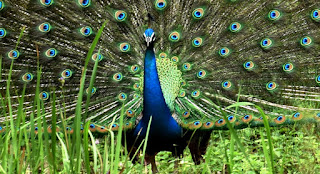Spice Gardens are very much on the
tourist trail, and are of different quality, one compared with the other,
dotted around spice growing areas. Their whole objective is to entice the
tourist to purchase product after seeing some spice plants and to a limited
extent demonstrations on how they are processed.
The reality of the farmer faced with
growing these spices commercially is a whole different subject, as issues
facing them don’t get highlighted on a tour of a Spice Garden, that is usually
located on the side of a main road, leading into Kandy or Matale from various
parts of the Country, and are of limited size.
Surrounding the hills of Kandy are the
main spice growing areas, but Pepper and Cinnamon grow more profusely in other
areas too, not just in just the hills referred to here. Sri Lanka is also
famous for Cloves and Cardamoms. Nutmeg on the other hand is a relatively
unheralded spice where the tree in fact produces two spices, namely, Nutmeg
(Sadikka) and Mace (Wasawasi), both of which are sold as spices, and are used
for flavoring of sweet and savory foods.
The hills on either side of the Weuda
Valley which extends from the Northwestern Province towards the Kandyan Hills,
a means of getting into Kandy from areas such as Galagedera, where the new
Central Expressway is to spill out before the approach into Kandy, is also an
area where spices are grown extensively, but latterly with climate change,
extensive droughts and invasion of the immigrant pests from other parts, has
created a nightmare for spice growers. It is here that I highlight some of the
challenges of growing nutmeg.
Nutmeg (Sadikka) is a spice grown in Sri
Lanka that is used for flavoring drinks and food, and is poisonous in large
quantities if ingested. In fact the nutmeg yields two spices, the kernel of the
seed which is what we generally refer to as the nutmeg, and the crimson mace
that surrounds the seed, that has to be carefully removed from the seed, and
dried prior to sale to the processors.
 In the past, in order to get the best
quality, the fruit was allowed to ripen on the trees, split open and fall to
the ground, to reveal the scarlet aril, better known as ‘mace’ which surrounds
the nut, They are then collected and taken from the fields. The scarlet mace is removed by hand carefully
and dried for sale separately from the nut. The nut has an outer shell which is
hard to crack revealing the kernel inside, which is the actual nutmeg itself
which is powdered for sale. The growers generally sell the nut with the shell,
for processors to do the rest, namely removing the kernel, as consistency and
hygienic standards can only be achieved by those who have the necessary
equipment, and can do it in the quantity that makes economic sense.
In the past, in order to get the best
quality, the fruit was allowed to ripen on the trees, split open and fall to
the ground, to reveal the scarlet aril, better known as ‘mace’ which surrounds
the nut, They are then collected and taken from the fields. The scarlet mace is removed by hand carefully
and dried for sale separately from the nut. The nut has an outer shell which is
hard to crack revealing the kernel inside, which is the actual nutmeg itself
which is powdered for sale. The growers generally sell the nut with the shell,
for processors to do the rest, namely removing the kernel, as consistency and
hygienic standards can only be achieved by those who have the necessary
equipment, and can do it in the quantity that makes economic sense.
Latterly, due to the menace of pests,
such as monkeys and giant squirrels to name the worst offenders, they pick on
the fruit while on the tree and often damage them, as the ripening process is
not uniform on a tree. Now it requires the laborious process of knowledgeable
pickers, who have to pluck these fruit when they know it is sufficiently ripe
and then take it away in bags for processing. This therefore is an added labor
intensive process, an expense, which was not the case in the past.
 |
| Mace - Red balance is the nut |
The pericarp of the fruit is edible and
is made into jams, but in reality most of it is simply thrown away, unless a
market is created by someone for fresh pericarp, in order to process it
further, and make it economical to save.
Farmers dry the mace and sell it to the
traders at the prevailing market price, and the seed is sold in similar
fashion, where, whatever the market price of the day is the price at which it
is sold. The farmer therefore is generally one who has only small quantities
for sale, and so has no bargaining power of his own to determine or influence
price, and so is at the mercy of the market makers, as far as price is
concerned. I would challenge, considering the effort to grow, protect, and
ensure the needed rainfall is obtained, producing nutmeg in Sri Lanka as a very
profitable business and I believe there are fewer farmers going into cultivation
of this crop. Wholesale theft of ripening fruit is also something to contend
with, unless the property is sufficiently well guarded.



